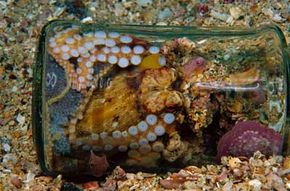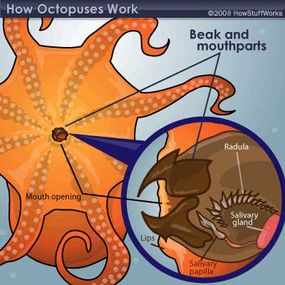Quck answer
Octopuses are highly intelligent creatures that have a unique ability to change color and shape. They have eight arms with suction cups that they use to move around and catch prey. Octopuses have a complex nervous system and three hearts, which help pump their blue blood. They have a beak-like mouth and can squeeze through very small spaces. Octopuses also have the ability to regenerate their limbs if they lose them. They are known for their intelligence and problem-solving skills, and have been observed using tools and even playing with objects like toys. Overall, octopuses are fascinating creatures with many unique features and abilities.
Wild Animals
Behavior of Octopuses

An octopus female uses a jar as her den.
Chris Newbert/Getty Images
Octopuses spend most of their time in solitude inside their den, venturing out at night to hunt. However, they tend to switch to a new den every week or two. The dens are usually found under rocks or in crevices, but some octopuses have been seen living in discarded bottles on the ocean floor.
Octopuses use different techniques to move around when they leave their dens. Many of them prefer to walk using the suckers on their arms to crawl along the sea floor. These suckers are sensitive, with up to 10,000 neurons in each, allowing the octopus to learn about its surroundings and locate prey. When they need to move quickly, octopuses can jet through water at speeds of up to 25 mph (40 kph) by taking water into their mantle and then forcefully expelling it through their funnel, propelling them in the opposite direction.
While the finned octopus (cirratte) uses its fins for swimming, the more common, non-finned octopus (incirrate) uses its arms for locomotion. The octopus uses various techniques to capture prey, such as using its arms to reach into crevices and its soft bodies to squeeze into tight spaces.

Close-up view of beak and mouth parts
Marcus Williams, HowStuffWorks
Octopuses don’t have teeth, but their mouths contain several tools to open shells and consume prey. They have a hard, retractable beak similar to a parrot’s, a barbed tongue called the radula to scrape prey out of shells, and a tooth-covered organ called the salivary papilla that can drill into shells and weaken prey for consumption.
The octopus has a unique way of catching its prey while swimming, by using the web of skin between its tentacles like a net before devouring it with its beak. Despite the effort required to make a meal, most species of octopus grow and gain weight quickly. Robotics engineers are also interested in the octopus arm, as it provides a good model for creating a strong yet flexible robotic arm that could be useful in surgeries or search and rescue situations.
FAQ
1. What are octopuses and how do they differ from other sea creatures?
Octopuses are a type of cephalopod mollusk that live in the ocean. They are known for their eight arms and their ability to change color and texture to blend in with their surroundings. Unlike other sea creatures, octopuses have a highly developed nervous system and are known for their intelligence and problem-solving abilities.
2. How do octopuses move?
Octopuses move by using jet propulsion, which involves forcing water through their mantle cavity to create a burst of movement. They can also crawl along the ocean floor using their arms and suckers to grip onto rocks or coral. Some species of octopuses are also capable of swimming using their arms as fins.
3. What do octopuses eat?
Octopuses are carnivorous and feed on a variety of prey, including crabs, shrimp, and fish. They are known for their ability to catch their prey using their arms and suckers, and they can also use their beak to break open shells and other hard surfaces.
4. How do octopuses reproduce?
Octopuses reproduce sexually, with the male using a specialized arm called a hectocotylus to transfer sperm to the female. After fertilization, the female will lay her eggs and guard them until they hatch. Once the eggs hatch, the larvae will float in the ocean until they are old enough to settle on the ocean floor.
5. How do octopuses defend themselves?
Octopuses have a variety of defense mechanisms, including changing color and texture to blend in with their surroundings, spraying ink to confuse predators, and using their arms and suckers to grip onto rocks or coral and avoid being swept away by strong currents.
6. How long do octopuses live?
The lifespan of an octopus varies by species, but most octopuses live for only a few years. Some larger species, such as the giant Pacific octopus, can live up to five years in the wild.
7. How do octopuses communicate?
Octopuses communicate using a variety of methods, including changing color and texture to convey mood or aggression, and using their arms and suckers to touch and interact with other octopuses. Some species of octopuses are also known to use visual displays to communicate, such as flashing their arms or changing the color of their skin in a specific pattern.
8. How do octopuses learn?
Octopuses are known for their intelligence and problem-solving abilities, and they are capable of learning and remembering complex tasks. They have a highly developed nervous system and can use trial and error to figure out solutions to problems. They have also been observed using tools, such as using coconut shells to hide or protect themselves from predators.





Leave a Reply